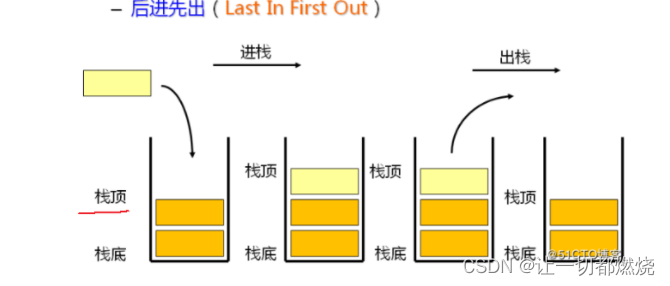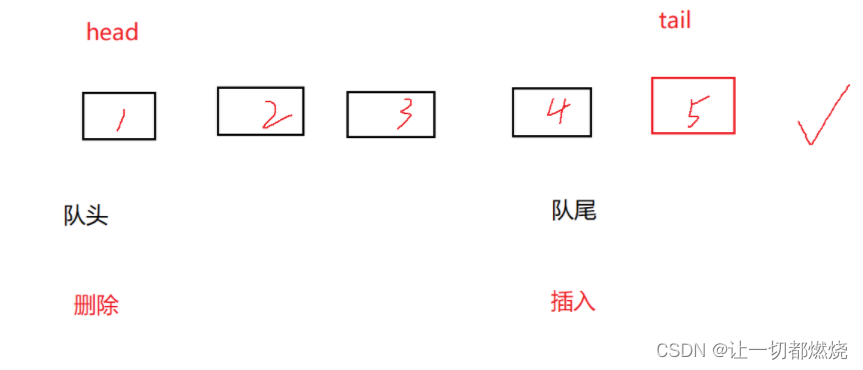目录
1.栈
1.1栈的概念及结构
栈:一种特殊的线性表,其只允许在固定的一端进行插入和删除元素操作。
进行数据插入和删除操作的一端称为栈顶,另一端称为栈底。
(顺序表和链表可以在任意位置插入和删除数据)
栈中的数据元素遵守后进先出LIFO(Last In First Out)的原则。

压栈:栈的插入操作叫做进栈/压栈/入栈,入数据在栈顶。
出栈:栈的删除操作叫做出栈。出数据也在栈顶。
1.2栈的实现
栈的实现一般可以使用数组或者链表实现
相对而言数组的结构实现更优一些,因为数组在尾上插入数据的代价比较小
栈是不能遍历的
完整代码
Stack.h
#pragma once
#include <stdio.h>
#include <assert.h>
#include <stdlib.h>
#include <stdbool.h>
静态栈
//#define N 10
//typedef int STDataType;
//typedef struct Stack
//{
// STDataType a[N];
// int top;//栈顶位置的标志
//}ST;
//动态栈
typedef int STDataType;
typedef struct Stack
{
STDataType* a;
int top;
int capacity;//容量
}ST;
// 初始化栈
void StackInit(ST* ps);
// 销毁栈
void StackDestroy(ST* ps);
//入栈
void StackPush(ST* ps, STDataType x);
//出栈
void StackPop(ST* ps);
//获取栈顶元素
STDataType StackTop(ST* ps);
//检测栈是否为空,如果为空返回非零结果,如果不为空返回0
bool StackEmpty(ST* ps);
//获取栈中有效元素个数
int StackSize(ST* ps);
Stack.c
#include "Stack.h"
void StackInit(ST* ps)
{
assert(ps);
ps->a = NULL;
ps->top = 0;
ps->capacity = 0;
}
void StackDestroy(ST* ps)
{
assert(ps);
free(ps->a);
ps->a = NULL;
ps->top = ps->capacity = 0;
}
void StackPush(ST* ps, STDataType x)
{
assert(ps);
//top是最后一个数据的下一个位置
if (ps->top == ps->capacity)//满了
{
int newCapacity = ps->capacity == 0 ? 4 : ps->capacity * 2;
//对原有的空间扩容,如果原有的空间是空就是malloc,不是空就是扩容
STDataType* tmp = (STDataType*)realloc(ps->a, sizeof(STDataType)*newCapacity);
if (tmp == NULL)
{
printf("realloc fail\n");
exit(-1);
}
ps->a = tmp;
ps->capacity = newCapacity;
}
//先放数据再++
ps->a[ps->top] = x;
ps->top++;
}
void StackPop(ST* ps)
{
assert(ps);
assert(!StackEmpty(ps));
ps->top--;
}
STDataType StackTop(ST* ps)
{
assert(ps);
assert(!StackEmpty(ps));
return ps->a[ps->top - 1];
}
bool StackEmpty(ST* ps)
{
assert(ps);
return ps->top == 0;
}
int StackSize(ST* ps)
{
assert(ps);
return ps->top;
}
Test.c
#include "Stack.h"
void TestStack()
{
//定义一个栈的结构体
ST st;
//初始化
StackInit(&st);
StackPush(&st, 1);
StackPush(&st, 2);
StackPush(&st, 3);
printf("%d ", StackTop(&st));
StackPop(&st);
printf("%d ", StackTop(&st));
StackPop(&st);
StackPush(&st, 4);
StackPush(&st, 5);
while (!StackEmpty(&st))
{
printf("%d ", StackTop(&st));//取栈顶元素
StackPop(&st);//下一个
}
printf("\n");
StackDestroy(&st);
}
int main()
{
TestStack();
/*char* p = malloc(1024 * 1024 * 1024);
printf("%p\n", p);*/
return 0;
}2.队列
与栈的性质相反的一个结构
2.1队列的概念及结构
队列:只允许在一端进行插入数据操作,在另一端进行删除数据操作的特殊线性表,队列具有先进先出FIFO(First In First Out)
入队列:进行插入操作的一端称为队尾
出队列:进行删除操作的一端称为队头
2.2队列的实现
队列也可以数组和链表的结构实现,使用链表的结构实现更优一些,因为如果使用数组的结构,出队列在数组头上出数据,效率会比较低

完整代码
Queue.h
#pragma once
#include <stdio.h>
#include <assert.h>
#include <stdlib.h>
#include <stdbool.h>
//设置两个指针
typedef int QDataType;
typedef struct QueueNode
{
struct QueueNode* next;
QDataType data;
}QNode;
typedef struct Queue
{
//int size;
//定义变量效率高,插入++,删除--最后返回size就可以
QNode* head;
QNode* tail;
}Queue;
//初始化
void QueueInit(Queue* pq);
//销毁
void QueueDestroy(Queue* pq);
//入队列
void QueuePush(Queue* pq, QDataType x);
//出队头的数据
void QueuePop(Queue* pq);
//获取队列头部元素
QDataType QueueFront(Queue* pq);
//获取队列队尾元素
QDataType QueueBack(Queue* pq);
//检测队列是否为空,如果为空返回非零结果,如果非空返回0
bool QueueEmpty(Queue* pq);
//获取队列中有效元素个数
int QueueSize(Queue* pq);Queue.c
#include "Queue.h"
void QueueInit(Queue* pq)
{
assert(pq);
pq->head = pq->tail = NULL;
}
void QueueDestroy(Queue* pq)
{
assert(pq);
QNode* cur = pq->head;
while (cur)
{
QNode* next = cur->next;
free(cur);
cur = next;
}
pq->head = pq->tail = NULL;
}
void QueuePush(Queue* pq, QDataType x)
{
assert(pq);
QNode* newnode = (QNode*)malloc(sizeof(QNode));
//检查野指针
if (newnode == NULL)
{
printf("malloc fail\n");
exit(-1);
}
newnode->data = x;
newnode->next = NULL;
//只需尾插
if (pq->tail == NULL)
{
pq->head = pq->tail = newnode;
}
else
{
pq->tail->next = newnode;
pq->tail = newnode;
}
}
void QueuePop(Queue* pq)
{
assert(pq);
//暴力检查
assert(!QueueEmpty(pq));
// 只有一个结点
if (pq->head->next == NULL)
{
free(pq->head);
pq->head = pq->tail = NULL;
}
// 含有多个结点
else
{
QNode* next = pq->head->next;
free(pq->head);
pq->head = next;
}
}
QDataType QueueFront(Queue* pq)
{
assert(pq);
assert(!QueueEmpty(pq));
return pq->head->data;
}
QDataType QueueBack(Queue* pq)
{
assert(pq);
assert(!QueueEmpty(pq));
return pq->tail->data;
}
bool QueueEmpty(Queue* pq)
{
assert(pq);
return pq->head == NULL;
}
int QueueSize(Queue* pq)
{
assert(pq);
QNode* cur = pq->head;
int size = 0;
while (cur)
{
++size;
cur = cur->next;
}
return size;
}Test.c
#include "Queue.h"
void TestQueue()
{
Queue q;
QueueInit(&q);
QueuePush(&q, 1);
QueuePush(&q, 2);
printf("%d ", QueueFront(&q));
QueuePop(&q);
printf("%d ", QueueFront(&q));
QueuePop(&q);
QueuePush(&q, 3);
QueuePush(&q, 4);
QueuePush(&q, 5);
while (!QueueEmpty(&q))
{
printf("%d ", QueueFront(&q));
QueuePop(&q);
}
printf("\n");
}
int main()
{
TestQueue();
return 0;
}2.3队列应用的两个场景:
- 排队,保持绝对公平性 (生产者消费者模型)
- 广度优先遍历 BFS